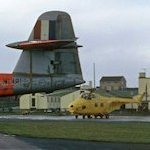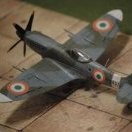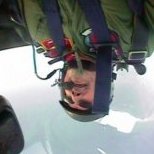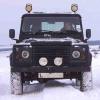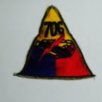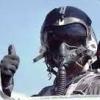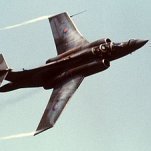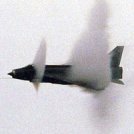Search the Community
Showing results for tags '1/72 Airfix'.
-
Hello all. I had a number of options for this Group Build but I was given this model as a Christmas present, so what better reason to enter it here? It is the Airfix 1/72 RNLI Severn Class lifeboat. I have had the pleasure of building one before which turned out okay: Thankfully this means that I know some of the kit's vices. Whether I remember them of course is a different matter. This is what the box is like, and what it contains: It has a lovely action shot on the cover, very eye-catching. Inside: Four runners of the newer dark grey plastic. It seems to catch the details well, and there is not (on first inspection) much flash. A nice colour painting guide, this should be a good test of brush painting (as was my completed one above). The transfers look good The clear parts are not crystal clear, but at least they don't have the 'dimples' that were in my previous one. I am still slightly tempted to use Clearfix, if I can work out how to stop a cloudy patch in the centre of the Clearfix appearing - it never used to The instructions now seem 'old school' compared to Airfix's current ones, but still presentable There are guide lines for waterlining the model, which is quite handy as that is what I want to do. I hope I can match them up on the four parts required to be cut. Way back in 2006, my good lady wife and I visited Brixham in Devon, and I luckily took a photograph of the local lifeboat: It shows the waterline to good effect, and the fact that some of the underwater red is visible, another thing to remember. I aim to build this one in a harbour scene (without the clutter of surrounding yachts and pleasure boats I hasten to add!), and add the buoys. I have an idea or two how to do the 'water', I will show you whether it works or not when the time comes. I will be portraying this as another lifeboat as I've already done this one. I am looking forward to the start of this Group Build, and I wish all of the other builder all the best with your builds. Ray
-
Hello all, I have just completed this Airfix 1/72 Fairey Swordfish MkI as a subject in the 'Here Comes the Fleet Air Arm' Group Build on this fine Forum. The build itself was a pretty easy one, with the exception of self-inflicted errors, all of which are readable here: The way Airfix designed the struts was phenomenal, and it made for a very easy way of fitting the top wing. In fact, the fit was so good I was able to fit the top wing assembly and the outer lower wings and they stayed in place without glue when I was test-fitting them. It is safe to say I had huge fun with this one. Thanks for looking, Ray
-
Hello all. This will be one of two entries for this Group Build. It has been in my stash since just after the initial new-tool issue, and this is the ideal time to build it. Here are the obligatory pre-build photographs: The scheme I will do will be the silver aircraft from HMS Courageous from 820 Sqn, March 1939. There is a reason (or two) for that choice - first, although I have built loads of the old-tool Airfix Stringbags, they have all be camouflaged and secondly, my other build will also be from HMS Courageous, but from earlier. This is the Swordfish scheme: I am looking forward to getting cracking with this. Any advice will be greatly appreciated, Ray
-
This is the 13th in my series of English Electric Lightnings that are now in my 'built' collection - the Airfix 1/72 F.2A. I have wanted to do a green/silver bird for quite some while, and I thought it was about time to drag it out of the cubby hole and build it. I was quite surprised when I looked in the box to see that I had started/raided it already! The instrument panel was missing, as was the instrument transfer, and I remembered that I had used it for an old Frog/Novo build that I did a few years ago in the Frog Squad Group Build in this very Forum. The build went well, aided by the fact that I had previously done (and had forgotten) all of the pre-build scraping of the nose and exhaust area interiors to aid fitting of the cockpit and the exhaust system. I must have done a grand job as the nose closed up superbly, better than any of the other three or four new-tool Airfix Lightning kits have done so far. I used Tamiya Bare Metal Silver from a rattle can for the undersides, and brush-painted ColourCoats RAF Dark Green for the uppers. Transfers were from the kit. Two coats of Vallejo Matt Varnish (diluted with a drop or two of water) finished it off nicely, with a slight sheen. Here is what I ended up with, a 19 Squadron F.2A from RAFG Gutersloh, late 1974 (apologies for lack of umlaut): I thoroughly enjoyed building this one, and I know I need two more of the F.2A's as I have to do a 19 Squadron Silver Machine*, and a 92 Squadron Green Machine* When I was breaking the box down for recycling, I found the 'used' instrument panel! Thanks for looking, Ray * anybody guess the connection (I am not thinking of Gutersloh, by the way)
-
This a departure from the norm for me, no not the subject, I have been known to make a Canberra now and then, no, in this case it's in a flight mode. The subject of the build is XH135 at the time of her second Sqn 13. The model will be one of four depicting XH135 at various phases in her time with the RAF, this is another departure from the norm for me as I tend not to build more than one of an individual airframe. The model is the Airfix PR.9 more or less out of the box, The base other than the frame is part of the wing of XH135 the rod is part of the fire detection wiring from her Avon RA.24, I've also managed to incorporate other elements of XH135 into the model. John
-

A famous Spitfire...in her original uniform!
Ralph posted a topic in Ready for Inspection - Aircraft
Evening all, Another addition to my Battle of Britain collection. I have Mk1 Spitfires as you might expect, but to date not a MkII, which only came on stream relatively late on. Its been v.interesting finding out about their service introduction. There's very little on the way of in service BoB photos which doesn't help but I did find info about P7350 of BoBMF fame. She flew during early September (including the 15th September aka BoB day) with 266 Sqn as UO*T. I had an Airfix Mk2 complete with the necessary Rotol prop and the Coffman starter bulge, and plenty of Xtradecal codes and serials...the only other additions were a Yahu panel and etched seatbelts. Painted with Tamiya sky and and RAF green with Xtracrylix dark earth. I also used masks for the camo pattern...a bit of a cheat but a good result! Anyhow, here she is, as she was 83 years ago!- 5 replies
-
- 35
-

-
- 1/72 Airfix
- 266Sqn
-
(and 1 more)
Tagged with:
-
Just completed, the recent Airfix 1/72 kit of the Gloster Meteor F.8, with my own markings for an Armament Practice Station Acklington, example from 1956. The APS Acklington was where, for 10 years, all RAF fighter Squadrons went for live gunnery training using the Druridge Bay ranges on the Northumberland coast. The APS had a full squadron's worth of Meteor F.8s, and as a reserve squadron they participated in RAF Air Defence exercises, scoring many 'kills', and they were also allowed to compete in the annual Fighter Command competitions. They were not too popular as they usually won! That's because all of their pilots were instructors, and they got lots of practice in their day job. VZ494, L, APS Acklington, 1956 (25) w by Philip Pain, on Flickr VZ494, L, APS Acklington, 1956 (29) w by Philip Pain, on Flickr VZ494, L, APS Acklington, 1956 (2) w by Philip Pain, on Flickr VZ494, L, APS Acklington, 1956 (27) w by Philip Pain, on Flickr VZ494, L, APS Acklington, 1956 (16) w by Philip Pain, on Flickr VZ494, L, APS Acklington, 1956 (5) w by Philip Pain, on Flickr VZ494, L, APS Acklington, 1956 (28) w by Philip Pain, on Flickr The markings shown were standard on all of their Meteors, and the 'squadron bars' replicate the towed-target markings. Their badge on the engine nacelles consists of the RAF Acklington APS crest flanked by the towed-target bars. I could not find a front view of their Meteors, so can not confirm that the individual letter 'L' was displayed on the nosewheel door. From photos, the following serials and codes have been identified - VZ494 'L' (small engine intakes); WA760 'R' (small intakes); WA963 'D' (intakes not known); WE855 'F' (small intakes); WH279 'X' (small intakes); WK932 'M' (small intakes); and WK985 'W' (large intakes). The two 'L' and 'W' had the four aerials on top of the wings, while 'F' and 'M' definitely had no aerials. Unfortunately, none of the available photos could identify which style of ailerons were fitted - I changed them three times on my model, but I'm still not sure! As for this new Airfix kit, it was a challenge. In very many ways it is excellent, but there are problems. The fit of the parts is far too tight with no 'wriggle room'. For example, the wings click on tight, but adopt insufficient dihedral in the process. The main undercarriage legs are in the 'flying' position and the model will sit too high on the ground. I just chopped a large chunk off where they were glued. The mainwheel hubs are wrong, being 'dimpled' on both sides. The port sides should have concentric rings as hubs. I filled the dimples in and painted rings on them. The cockpit floor extends too far forward and fouls the nose bulkhead. Chop a lump off the front of the floor. The wing trailing edges are far too thick and thinning the insides doesn't work as it will affect other parts. So I thinned them on the outside as best I could. There are a couple of parts shown on the construction diagrams which aren't in the kit, namely the support for the nosewheel door, and the 'towing lug' (?) for the rear of the belly tank. The mountings for the four top-of-wing aerials are moulded on the upper wings, but if your chosen aircraft didn't have the aerials then the mountings need to be sanded off. Will I build any more examples of this kit? Yes, definitely, and hopefully my lessons learnt will shave a couple of weeks off producing the next two.
- 15 replies
-
- 53
-

-
- Armament Practice Station
- RAF Acklington
-
(and 1 more)
Tagged with:
-
Greetings. Since I got the wonderful book "Spitfires in the Sun" written by @Linescriber I have tried my hand at some of the wonderful Spitfires profiled in the book. This is MA368, one of the rare handful of Vs that flew in India. When it arrived in India and delivered to 607 squadron RAF, it was in the Middle East scheme and after a cpl of different paint jobs ended up in the correct temperate land scheme with 16" ACSEA blue India roundels. Shown here as it was with 1 SFTS at Peshawar and Ambala. The kit itself is nice and gets you excited for a bit before disappointing you as well. The fit is fine though requires some muscle and putty for the wing root and vokes filter fitting. They have even included decals for parts not in the kit like the fuel cap on the nose 🤷🏻♂️ and missing some parts altogether like the rearview mirror. A thin cockpit door would have been a nice option for those of us who like to build it that way. I still need to sand the door thin but calling this done for now. The rearview mirror comes from the Italeri kit. Paints are Tamiya. I am not a very good photographer so please pardon the quality of the images as I used my very outdated phone camera. Here is the link to the build thread. Thank you for looking 🙏
- 10 replies
-
- 29
-

-
- 1/72 Airfix
- Spitfire Mk Vc
-
(and 1 more)
Tagged with:
-
81 Years ago to the day, on the 15th September 1940 P/O Cooper-Slipper of 605 sqn heard the scramble at the dispersal at RAF Croydon. It was the height if one of the most emblematic battles in the UK's history. Racing to his regular plane, he found it unserviceable, so he made for one of the reserve 'planes, Hurricane L2012 UP*V. Climbing into position, he came through clouds and almost instantly collided with a Dornier of Kg3, ripping the wing off his fabric winged Hurricane and sending both planes down. He luckily managed to get out to fight another day, even if the same could not be said for the Hurricane. Nevertheless, it accounted for an enemy aircraft; the score was even. The inspiration for this project was both my abiding interest in the BoB, and a rather more niche interest in early fabric winged Hurricanes that survived to fight in the Battle. The inspiration came from a photo from Dilip Sarkar's BoB Kaleidoscope books and help from Andy of Britmodeller provided the elusive code letter-thanks to him! Bae kit is the Airfix 1/72 Hurricane, with Yahu instrument panel and seat belts, resin five spoke wheels, an Arma open Hurricane canopy, and scratch built details such as the bespoke mirror fitted to the windshield. Paints were a mix of Tamiya and Xtracrylix, with decals a mixture of kit and Xtradecal generic letters and numbers. I rounded it off with a trolley acc from Flightpath. Thoroughly enjoyed this project, and my way of marking those now far off events that nevertheless continue to shape our lives. Work in progress link below, along with pics.
- 5 replies
-
- 33
-

-

-
- 1/72 Airfix
- Battle of Britain
-
(and 1 more)
Tagged with:
-
I recently completed the seventh addition to my collection of Wisconsin Air National Guard aircraft, the OA-37B "Dragonfly", which left just two more aircraft to complete my project: the A-10A Thunderbolt II (a.k.a. "Warthog") and the O-1A Cessna Skymaster. I've never been a fan of the Skymaster, mainly because that's the aircraft the Wisconsin ANG was given when their F-102 Delta Daggers were taken away from them. Imagine, going from a supersonic hotrod to a pedestrian, prop-driven general aviation aircraft! But, that's what happened. In 1974 the Wisconsin ANG's 115th Fighter Group converted to the forward air control mission and became the 115th Tactical Air Support Group, trading in their Delta Daggers (top speed: Mach 1.22) for Cessna Skymasters (top speed: 200 mph). The group flew Skymasters until 1979, when they transitioned to the OA-37B "Dragonfly". My plan was to begin work on the A-10 as my next Wisconsin ANG model. However, a few aftermarket items I had ordered hadn't yet arrived, so I decided to do a quick build of the Airfix Skymaster sitting in my stash. My thought was, being a simple kit, I could get the Skymaster done in a few days (a week at most) and then start on the Warthog. No WIP, just build the Skymaster and post a quick RFI. Little did I suspect . . . Here's the kit: And a dog it turned out to be! Bear with me while I do some belly-aching (and feel free to bring out the violins!) For starters, the clear parts don't fit at all. The windscreen is too wide, the openings for the side and top deck window are much larger than the clear parts meant for them, and the windows on the lower right-side are pure trash (wrong shape, and too small for the fuselage openings). I ended up cutting a vertical slice from the windscreen, to narrow it down, and replaced the top deck with a new piece, for which I cut properly-sized openings. I also replaced the lower-right side of the fuselage with new styrene, and created correctly shaped & sized windows using clear UV acrylic: The twin booms are another problem area. They are supposed to fit into slots in the wing, but the slots are much too wide. I corrected this using styrene shims: Airfix's interior is for the four-seat civilian Skymaster. I removed the two rear seats and scratch built an electronics rack. Unhappily, not much of this can be seen through the kit's thick windows: Those are the biggest problem areas. The rest of my work consisted of adding details that are missing from the kit. I opened the forward engine air inlets, and made an inlet for the rear engine (the kit has this as a blank face): I lowered the flaps to match the photo at the top of this page of a Wisconsin ANG Skymaster on the ramp: I added landing/taxi lights on the wing leading edges, made from adhesive fingernail "gems" and packing tape: I used thin brass tubing to create exhausts for the two engines: I replaced the crude underwing pylons with better ones from the spares box. I used aftermarket items for the rocket pods, as the kit items were simply horrible: The fuselage top is bedecked with various antennae, which I added, along with PE fuel filler caps on the wings: The kit is missing the anti-collision beacon on the starboard fin, so I scratch built one using styrene rod and UV-activated acrylic gel, coated with transparent red paint, for the lens: I also used the UV gel to create the wingtip navigation lights and the clear lights at the rear of the fins: Lastly, I made a pitot tube from brass rod and a bit of styrene, to replace the kit's crudely-molded item: I painted my Skymaster with MRP Sky Grey paint and Mr. Base White 1000, referencing photos of Wisconsin ANG birds: While I was painting and masking, Airfix's iffy landing gear gave way. After gluing the broken pieces together, I added reinforcement using CA glue and baking soda. The result definitely isn't scale, but at least I have some peace of mind. Decals were mainly from the kit (this boxing has decals by Scale Masters, which performed beautifully even being decades old). I printed custom decals for the Wisconsin ANG, and also used a few decals from the spares box where needed. -------------------------------------------------------------------------------------------------- Now (if you're still with me), let's see the results of all that work! One more pic, this time in an appropriate setting: And finally, to give a sense of scale . . . . Thanks for viewing, and thanks to everyone who followed my build and gave me support during this challenging project. And, if you are interested, the details of the build are in my Work In Progress:
-
Hello all. This will be my second contribution to the 'Less than a Tenner' Group Build. It is the recent red-box issue of the somewhat ancient Albatros DVa (it is as old as me - we were both born the same year!). Quite a few years, my wife and I had a day out in Oxford, and, as you do, I found a 'model shop' in Boswells, and snapped this up for £5 as a memento of our fabulous day out. Jane then promptly snapped it out of my hands and put it away and I got given it back that Christmas. There is not a lot of parts to the kit, which are in a grey plastic (unlike my bagged version which is in pale blue plastic). Surprisingly at first glance there is not much flash, but plenty of stuff that need doing (see the ejection pin marks on the upper wing surface? - why did they do that?) The transfer sheet looks very well printed, and there are not many stencils on this - yippee! This model has two marking options: The one which really took my fancy was the one with the wooden varnished ply finish and the red nose, but that is Manfred Von Richthofen's machine, and he gets too many of his planes built, so I will go for this one instead: This one looks nicely different, with a black fuselage, duck egg blue undersides, and a camouflaged pair of wing and tailplane upper surfaces. And that flag looks fun too. I will have to do some research to find out if I can learn anything about the pilot. I say that this will be OOB, but the question is, will I succumb to adding an extra detail or two or not? - Please bear in mind that the guns are, how shall I put it? - interesting. Find out in the next thrilling episode! All the best, Ray
-
Hi All, Another Build, this like the Meteor to be reasonably quick-ish builds (yeah I know famous last word right ) When folks think of New Zealander's and Mosquito's, they would think Raids on Gestapo HQ/Amiens etc. Two Article XV Squadrons flew them in the ETO during WWII, the likes of 487 Squadron Mosquito, HX855 EG-O 487 Sqn attack on Gestapo Headquarters at Aarhus, Denmark (RNZAF Official - RNZAF Museum - Used with Permissions) 488 Squadron (this Squadron forming at1941 at Rongotai in New Zealand, and our first true Fighter Squadron) Possibly Gilze-Rijen, Holland. (RNZAF Official - RNZAF Museum - Used with Permissions) The New Zealand association with the Mosquito didn't end with the close of WWII. In 1946 and 1947, the New Zealand Government purchased for the RNZAF a number of Mosquitos, both from Britain and Australia The below are some of the Aussie Mosquitos preparing to leave RNZAF Station Whenuapai for RNZAF Station Ohakea the first two are A52-1005 and A52-1006 Respectively (RNZAF Official - RNZAF Museum - Used with Permissions) The Mosquitos from Britain were flown out by RAF/RNZAF Aircrews - A number of these (along with some of the Australian Mosquitos were put into Storage (much like the Mustangs), a number being brought back into service early 1950's The main operator of the Mosquitos was 75 Squadron, now a true/total RNZAF Squadron. These operated from RNZAF Station Ohakea coded YC - * (RNZAF Official - RNZAF Museum - Used with Permissions) The predominate Colour was HSS (High Speed Silver) as in the above photos, however there were a few that retained the RAF Camouflage, even Roundels/Codes/Serials for a short period of time or Service. (This was not untypical of RNZAF practice, especially during WWII a number of aircraft types wore the Roundels they arrived in for a period of time) This is an Airshow at RNZAF Station Taieri - Note the two RNZAF Mosquitos in Camouflage, the closest is R-9Y(?) RAF Serial PZ474 - RNZAF Serial NZ2384 (RNZAF Official - RNZAF Museum - Used with Permissions) The RNZAF during these years the RNZAF loved like any other Air Force, to show the good people of New Zealand their wares and prowess and also participate in Exercises. Open day at RNZAF Station Whenuapai -75 Sqn Mosquitos taxiing past the Headquarter Buildings - Note 40 Squadron Hangar in the background (RNZAF Official - RNZAF Museum - Used with Permissions) Armed and ready for Bear (we don't have bears in NZ ) 75 Squadron at RNZAF Station Ohakea with Exercise Hardtack (who dreams up these names ) - Note rockets on the rails (RNZAF Official - RNZAF Museum - Used with Permissions) Like anything, all good things must come to an end, and make way for more advanced types, the Mosquitos were slowly withdrawn from Service, put into Storage and eventually sold for scrap Funny thing about New Zealander's, is our Number 8 Wire attitude, a number of ex RNZAF Aircraft were acquired by Farmers/Orchards and appeared in strange places with strange uses. Aircraft wheels for trailers etc. Merlin Engines were used for helping keep frosts off Flowering trees in Orchards, my Grandparents telling me in country areas you could hear the rumble of engines at dawn on these farms/orchards A few pics of these aircraft in various states of disrepair Warning on this, if aircraft destruction is not for you look away now Anson NZ1349 and unknown Mosquito (in camouflage) behind, most likely as part of a "tender" package at an RNZAF Station, being scrapped in situ (RNZAF Official - RNZAF Museum - Used with Permissions) Hudson NZ2013 on a Farm at Oamaru (South Island) before being rescued by RNZAF Museum (RNZAF Official - RNZAF Museum - Used with Permissions) Avro 626 NZ203 being recovered by RNZAF Museum, from a farm in North Island (RNZAF Official - RNZAF Museum - Used with Permissions) 75 Squadron Mosquito NZ2308 - YC-Z at an unknown farm in New Zealand - fate unknown (RNZAF Official - RNZAF Museum - Used with Permissions) This last photo acts as a conclusion for my preamble above, some of these Mosquitos survived and were rescued We have one here in Auckland at MOTAT, it being one of the Aussie birds A52-1053. began life as a FB.40 serialled A52-19, but was converted mid production to a T. MK 43 Trainer and serialled A52-105, arriving in New Zealand from Aussie 1947. It was given the RNZAF Serial NZ2305. One of the ones put into storage, it was SOC and sold to a farmer in Marton, where it sat until circa 1967, when in a derelict state it was donated to MOTAT Needless to say after a long rebuild/preservation process the aircraft was put on display albeit not quite complete Outside at MOTAT Some years later inside and looking decidedly much better Sooo, with that what am I going to build? Well a 75 Squadron Aircraft likely one of the ones in either Exercise Hardtack, or doing the Roll by at Whenuapai NZ2349 YC-C So Requisite Photos of Kit (not much to see) Box art Kit parts Kit Instructions The marking to be from Old Model Decals Thanks for looking in, more soon Regards Alan
-
Hi After the construction of the Boeing F4b-4 I was wondering what to choose as a new project. My choice fell on Wellington from the Brooklands Museum. I thought about it ever since I saw the picture on the cover of the aviation magazine and read the article about this particular aircraft few years ago. I want to do it exactly as it looks in a museum. That's why I flew from Poland to the museum to make my own photographic documentation. I also made contact with the museum, which promised to help in the project. I will use Airfix kit for construction, at least three. My monster in the original. First cut Regards Tomasz Hajzler
-
Hi All, Had a Chat with the GB Mods and I'm going to resume my activity on this GB. I felt at the time it was prudent to be absent (No I wasn't throwing my Toys out of the cot) and we'll leave it at that. I will state unabashedly, and unapologetically that I am very passionate about mt Country's Air Force, It, having been in my life since I was born, and still is (note the Beautiful RNZAF 757 outside Air Movements RNZAF Base Whenuapai) NZ7571 at time of Photo, had carried our current Prime Minister on her travels, it can be fitted with a VIP Suite (I really would like to do one of these - one day ) I will as always be most happy to provide Accurate Technical/Historical assistance as required Anyway I digress The subject of my current build (I'll get back to the Huey at some point) is a very important one, a milestone in Our Country's History, but also a Milestone for the RNZAF January 1946 on Loan from the RAF, Gloster Meteor Mk III (EE395) arrived in Auckland and was transported by Barge from Ports of Auckland to RNZAF Station Hobsonville in the upper Waitemata Harbour This is EE395 after coming of the barge and being towed up the hill to the upper hangars for final assembly (Been up and down that hill many a time) (Whites Aviation - National Library - Used with Permissions) Sitting outside Marine Section Hangar Prior to going up hill (Whites Aviation - National Library - Used with Permissions) Once Assembled, the Meteor was flown on a Tour around the Country by Squadron Leader Bob McKay (RNZAF Official - RNZAF Museum - Used with Permissions) This is EE395, now NZ6001 at least by or after March 1946 at Whenuapai (RNZAF Official - RNZAF Museum - Used with Permissions) NZ6001 is parked near the Base Headquarters Building with what is now, 5 Squadron's Hangar in the distance. Note the retention of RAF Roundels/ Camouflage Scheme. - Note No Zapping then The astute among you will notice the RNZAF Dakota behind NZ6001 still with WWII Pacific Roundels, and the C60 VIP Lodestar forward At this time the RNZAF was in a State of Flux with markings with WWII and Post War Roundels being worn - there are some today who ardently believe that the RNZAF went back to the Pre War Light Blue -I don't believe so. NZ6001 beating up RNZAF Station Ardmore (South of Auckland) (RNZAF Official - RNZAF Museum - Used with Permissions) Over the next 4 (or so years) NZ6001 was used to train up new RNZAF Pilots, who from 1950 would fly the DH Vampire when they arrived in New Zealand - During this time NZ6001 also came under the Charge of 75 Squadron (Easter Egg here). In 1950, NZ6001 was retired from Flying, now also owned by the RNZAF, becoming an Instructional Airframe (INST 147) at the TTS (Technical Training School) Hobsonville - Being SOC (Struck Off Charge) 1957 - It's possible My Dad may have learned on NZ6001 as he was in The RNZAF by this time NZ6001 in same Hangar as she was assembled in, as INST147 (RNZAF Official - RNZAF Museum - Used with Permissions) This is the Rear section of above Hangar at Hobsonville - have been in there during RNZAF Use Unfortunately NZ6001 was scrapped, but part of her is still with us today, as the two Derwent Engines were saved. One is with the RNZAF Museum Christchurch, and the other is on display at MOTAT here in Auckland Well after all that, there's not much more to add other than the requisite Pics of the model Box Top Parts List is not so large Kit Instructions Kit Decals, which I will use some of Thanks for looking in, more to come soon Regards Alan
-
First, my apologies for the dilatory approach to posting for this build .... as in, none .... so far. I suppose I am a rather existentially challenged group builder! But, I have indeed been keeping up, watching builds in progress and, most importantly, I have been building along. Super job on your builds everyone; thanks for taking the time to post them! Admittedly I started this build before the beginning date, but it was less than a quarter way there by the start date, I submit, and besides that, I am just getting my act together for a post two-thirds of the way through the group build. This should - in theory - curve the space-time continuum just enough to make the timing of all this copacetic enough for publication at this time. I'll start posting now. Be warned, if you were to happen to follow the flickr links on my photos you may also be inexplicably propelled into the future. So here are the build pictures even if not in real-time, nor exactly on-time! The inspiration for this build: ; ; I thought it would be fitting to do my first build of the new Airfix kit as the first production Mk.2 Buccaneer - XN974. The first of the few as it were, although I think it will be the first of several builds of this kit for me I suspect. I am going to build this one wheels up as in the picture, beating up the aerodrome at Brough in May 1966. Of course, it will take pilots too, and I took the opportunity to upgrade the crew with figures from PJ Productions. And some references to help me along the way: As with most airplane model kits, things begin with the cockpit. I built it up first and then painted it and added the kit decals. That will be plenty good for an in-flight model with figures in the seats. It is a cleverly engineered kit. It doesn't take long to get to this point because it is fun to see how it goes together. Building the landing gear bays closed was easy enough. Just cut the locating tabs and lay the in place. Then the sanding began which is where things slowed down a bit. I'll post more tomorrow night. Sorry for the untimely post and lousy iphone pics. - Jack
-
Good morning All, firstly a thank you to Jockney for allowing me to join the GB with this entry; the Airfix 1/72 Fairey Rotodyne. The history of the aircraft and its eventual cancellation are fairly typical of the British aviation industry of the late fifties and early sixties, but I won't dwell on that here. The Airfix mould originates from 1959 with all that entails including rivets everywhere, big sinkmarks, approximate fit of parts and moveable control surfaces and undercarriage. It has no cabin interior and a brief thought about trying to scratch a representation of the instrumented interior of the prototype was quickly snuffed out; I lack the skills and patience. So, what of the kit? I picked up the Airfix Rotodyne and the Revell kit as part of a bundle a few years ago for not a lot of cash. The Revell kit mould dates from 1961 and has far more detail including removeable panels and a complete interior, in the slightly odd scale of 1/78. I have the 1996 reissue of the Airfix kit and the 2009 reissue of the Revell kit. TheAairfix kit has no box and came in a ziplock plastic bag, though is complete and has decals and instructions. Side by side there is a noticeable difference in size, but the Revell kit had plenty of its own rivets. I quite like Revell's boxing of other makers' models such as Matchbox and Hasegawa, but their own kits that I have experience of always seem to have loads of flash, poor fit and warped parts. This one is no different, and is moulded in the good old fashioned favoourite of silver plastic. I may try my hand with the Revell kit, but I will start in with the Airfix offering first. I am not sure how this was stored in its plastic bag, maybe in the sunshine somewhere, but the model's grey plastic has gone a not very fetching beige in places. Fortunately it has not gone brittle. The rivets will respnd well to a gentle sanding, but the sink marks that festoon the surface will require a little more work. First job. On the upper surface of the wings is an intake, which in the original was the intake for the compressors that provided the high pressure air to the rotor tip 'jets' to spin the blades for take off and landing. I set about thinning these with a dremel and a judicious scraping with a scalpel. This made quite a difference to their appearance. 20200708-TE intake by Dave Farrow, on Flickr I am back to Mike Grant's tips from his 'Circuits and Bumps' series back in 2011 for this next one for making blanking pieces or bulkheads. He used plasticene to make a plug inside a fuselage, then stuck it all in the freezer to harden a bit. Once properly cold and quite stiff the plug was removed and sliced with a scalpel. The sliced section was placed face down on to a piece of plasticard and paint sprayed around the edge to give a 'positive' of the shape, which could then be carefully cut out and filed/sanded to match the interior of the section to be filled. My plugs for the main undercarriage bays weren't perfect, but they made making blanking plates really easy. I hadn't really thought about it until I started to put this together, but it's a big ole unit. Rotor span if the prototype was in the region of 90 feet (27m for you modernists), which might not mean much until you have something to compare it to. Next to the same scale Mi-24 Hind-D, which is no small beast itself, gives some appreciation of how big it really was. I have also remodelled the rotor mast so the rotor is both free to move and removeable and will add a photo or two in the next progress post.
-
Hello all. I have just finished this little beauty of a kit, the Airfix 1/72 Tiger Moth. It is the second of these new toolings that I have finished, and I have enjoyed both! The kit itself is delightfully moulded, but there were some mould blemishes on one of the interplane struts, along with some flash but neither were a problem to sort out. I needed some filler between the cockpit openings but that was pretty much that. The only parts I really had problems with were the main undercarriage parts, and that is only because of my ham-fistedness. I decided to add the wheels right at the end having test fitted them, but when I did, the undercarriage disintegrated! Thankfully, ala Hot Chocolate, I put it together, again. This time though, I added the wheels first - should of (have?) done that first time. The model did get rather fragile towards the end. I brush painted with Colourcoats Foliage Green, varnished with Revell Matt varnish acrylic and rigged with InfiniModel rigging line. All in all, I loved the build. I did not add the cross-bracing between the rigging wires though. I may try that later. I also photographed this with the other one I did, from the original boxing of this new tool kit: Thanks for looking, Ray
-
Hello everyone... This is my second of three builds from the Battle of Britain group build. It is the 1/72 Airfix Boulton-Paul Defiant Mk.I. It is out of box and wearing the markings of 264 Squadron July 1940. Ive always had a soft spot for the Defiant and it was a pleasure to build the kit. Hopefully Airfix will send it up to the 1/24 scale line of models. It would be one of the few large scale planes I would ever build. Please feel free to ask questions, post comments, and or add thoughts. I will add a link to the build thread for anyone interested. Dennis
- 8 replies
-
- 27
-

-

-
- 1/72 Airfix
- B-P Defiant
-
(and 1 more)
Tagged with:
-
Hello all! Although I love to build the new, super-duper kits that are extremely well detailed and fall together well(Ish), I do have a hankering for the 'older nostalgia' type models. I have built quite a few over the last couple of years, and that has taken me back to my childhood (too many years ago now!). Well, one model I remember from 1969 was this one, the Airfix Ford Tri-motor. I cannot claim this will be a nostalgia build, in view of the fact that I never had one, but one of my friends in Singapore showed me one when I was building a Boeing Clipper in 1969, and I thought I should have a go. It is now some years later, and finally I got one (not that I tried very hard during that time) from good ol' KingKit. The version I got was the Red Stripe boxing, which I think was the first: The contents were excellent, barely any flash on the parts, which reinforces the 'early' thought - here are a few: One very odd point I have noticed is that some parts have numbers on the runners, others do not! I thought that was a little odd, until I realised that most of the numbered parts are those that could cause confusion as they are port/starboard options. Now, as this is a tri-motor, it has a lovely build feature, in that it was corrugated. Airfix have captured that well to my eyes: Another good thing is that it comes with an excellent descriptive instruction sheet, so you know what the parts represent as you build! There was a hitch though! For the life of me, I could not figure out in some places what went where! I searched the web for a more modern instruction guide (ATF, Scalemates, suggestions on the BM 'Instructions wanted' page, Google etc) but had no luck, then I popped a request on good old Britmodeller, and @dogsbody came to the rescue with some pictorial guides: Thanks for that! They helped me out no end, especially for the interior fitting, and, I suspect, later on for the outer engine fittings and undercarriage. With the written instructions, no matter how I looked and read them, they made no sense. This is not necessarily a problem with them, I do sometimes get that when I am just reading a book! I look at the page and nothing sinks in. I hope it is not a sign of things to come... I intend to build it as this: It comes from a very colourful sheet by Blue Rider: Naturally, I chose the least colourful of the lot, and will only use four transfers - the serials and the Ford logos. The upside is that I will not have to try and get too many markings down on the corrugations, and all four are on the same part which can be fitted when painted and decalled. I will leave it at that for the introduction. Take care all, Ray
-
Hello everyone... My first build for this is going to be Boulton Paul’s Defiant. I will be using the 1/72 Airfix kit in the kits markings of PS*U from 264 Squadron. Ive always had a weird attraction to the Defiant. I have often wondered if it had some forward firing guns along with the turret if it might not have done a bit better. Please feel free to ask questions, post comments, and or add thoughts. Dennis
- 66 replies
-
- 20
-

-
- B.P.Defiant
- 1/72 Airfix
-
(and 1 more)
Tagged with:
-
I thought it best not to incur the wrath of Julien or Mike, so I will post this as a new forum discussion topic instead of taking the original topic on 1930's biplane finishes further off course. Pulled several kits out of storage after reading the comments on the 1/72 Airfix Bulldog prop. For what it's worth, here goes! The Airfix prop is indeed bass ackwards, with the flat side to the front and the airfoil side to the rear- very, very difficult to correct, especially as the prop blades are molded to the spinner and Hucks starter dog. The prop and spinner from the Matchbox Siskin is a very good match- correct length, blade profile, spinner, and rotation. The prop and spinner from a Matchbox, Heller, or Frog Gladiator are very good matches as far as the prop blades are concerned, but the spinners are not the same as the ones on the Bulldog- again, very hard to correct as the blades and spinner are molded as one. The spinner from the Matchbox Fury is a match, but the direction of rotation is the opposite of the radial-engined Siskin and Gauntlet/Gladiator/Bulldog. (I don't have any of the Gauntlet kits- Aeroclub or AZ, but I would think they would work as well. I know Airfix is about to re-release their Bulldog, and while I am betting it will have new, much nicer decals, I wish (and it's a dream, I know!) they would consider adding a new sprue with a correct prop, and cockpit parts- they could do the same for the Demon, and I sure wouldn't mind paying more for a "revised" tooling! Mike
-
As a bit of a follow on from my recently finished Boeing 720 'Led Zeppelin' model, I decided to keep things non-military again and build something that I have really wanted to do for a very, VERY long time. This goes back to when I was a very young lad, and was memorable for me bacause it was the very first time that I ever flew in an aeroplane, which was quite an event for me at the time of course, and I can still remember how much I enjoyed it. I was very much into aircraft and model building even then, and since then have always toyed with the idea of building the first aircraft I flew in. The occasion was our first family holiday 'overseas' back in the early 70's, which was to Jersey, in the Channel Islands, and we flew out of Norwich Airport (formerly RAF Horsham St Faith) in my home City. The aircraft in question is the DH 114 Heron of 'Channel Airways' and the kit is the jolly old 1/72 Airfix one. The one I shall be building is G-AXFH, pic in the link below. As a bit of a side-note, the picture below states it is taken at Southend (Channel Airways were based out of Southend) but myself and a friend of mine, Mike H, have a slight doubt about that, and the pic may 'possibly' be taken at Norwich Airport instead. We are still looking into that .... https://www.airteamimages.com/de-havilland-heron_G-AXFH_channel-airways_180161_large.html Being of a certain vintage of course, the 1/72 Airfix kit is obviously not state-of-the-art as of today, so things will be changed/modified/scratchbuilt, and some of the things that will need attention are: Exterior airframe surface: All detail will be removed and rescribed. The interior: There isn't one .... . There are two very basic cockpit seats and instrument panel (no control columns) and pretty much nothing in the passenger cabin, so all 14 seats will be cast in resin and added. Transparencies: Cockpit canopy is of the wrong type for the aircraft I am building (it has the bulged section that protrudes above the fuselage) so this will need modifying. Fuselage windows look to be pretty accurate size-wise, but the corners are too 'square' and should be more rounded, and the clear window mouldings have horrible sink-marks/dimples from the moulding process, so these will be changed. Landing light needs adding under the wing. Also the small square windows on the starboard side of the fuselage and port side passenger entry door, aft of the main passenger windows, are slightly too small and too low. They should be the same centre height as the main windows. Wheels/undercarriage: Kit has the retractable type undercarriage which is wrong for the aircraft I need, so will be changed to the fixed non-retractable type. Wheels are horrible and will be changed. Engines/overwing nacelle fairings: Engines look very basic, small intakes on them are very non-descript 'lumps' and the intake at the front, below the prop hub, is too small. The overwing nacelle fairings do not extend back far enough towards the trailing edge of the wing. The inboard ones need to extend back maybe a couple of millimetres, and the outboard ones maybe around 3mm or so. New engines and overwing fairings will be cast in resin. Wing tips: Need to be squared off. Fin/rudder: Again, the one in the kit is wrong for the aircraft I am building. The rudder will be modified into the taller, 'pointier' type, and it and the fin tip will not have the characteristic bulge on them as per the kit one. No doubt there will be other odds and ends that need sorting along the way too .... Have made an initial start on some of the modifications, and the pic below shows the new overwing nacelle fairings, the 14 passenger seats for the cabin and also the new engines, all cast in resin. With the engines, I added a finely finned section just inside the intake mouth to hopefully simulate the appearance of an engine cylinder/barrel, although it is not really visible in the pic. Hopefully should be more apparent with a drop of paint on it. As we are now travelling back in time to the 1970's, any references to Kipper Ties, Flares, Glam Rock, The Double Deckers, Tiswas, Spangles, Corona, Space Hoppers and Raleigh Choppers are not only tolerated they are positively encouraged. 'Jumpers for goalposts ......'
-
I hadn't signed up for this one,i thought i had, I was thinking of building my special hobby brewster 239 in 1/32, but I've decided on something else, that continues my diversion into 1/72 ,the superb little airfix gloster gladiator,in finnish livery ,i have some extas, they are, aml decals sheet 7201 ,sbs photo etch exterior, eduard photo etch interior, sbs resin bristol mercury engine,aires resin doors, and resin control surfaces, I'll also attempt to rig it, I'm undecided on the scheme at present Cheers all
-
Moved from the recent Flying Boats and Float Planes GB John
-
Another of last year's builds. Cracking little kit although i found the undercarriage assembly a little tricky, but that might be my fault. I've the Royal Navy one in the stash so I'll see if i can do any better next time. Used a bit of artistic licence and swapped the small fuselage roundel in the kit for a larger one from the spares box as i seem to have seen both variations used at the same time in photos and i much prefer this look. Brush painted by Vallejo Model Air and Model Color, plus their matt varnish. Panel wash by Mig and some Tamiya weathering powder to finish. Cheers for looking.

.thumb.jpg.ba34a9f6ddce411193946dbdcc7b5fe8.jpg)
.thumb.jpg.158e2e086d45b8f96b7d93b8bee8dc21.jpg)
